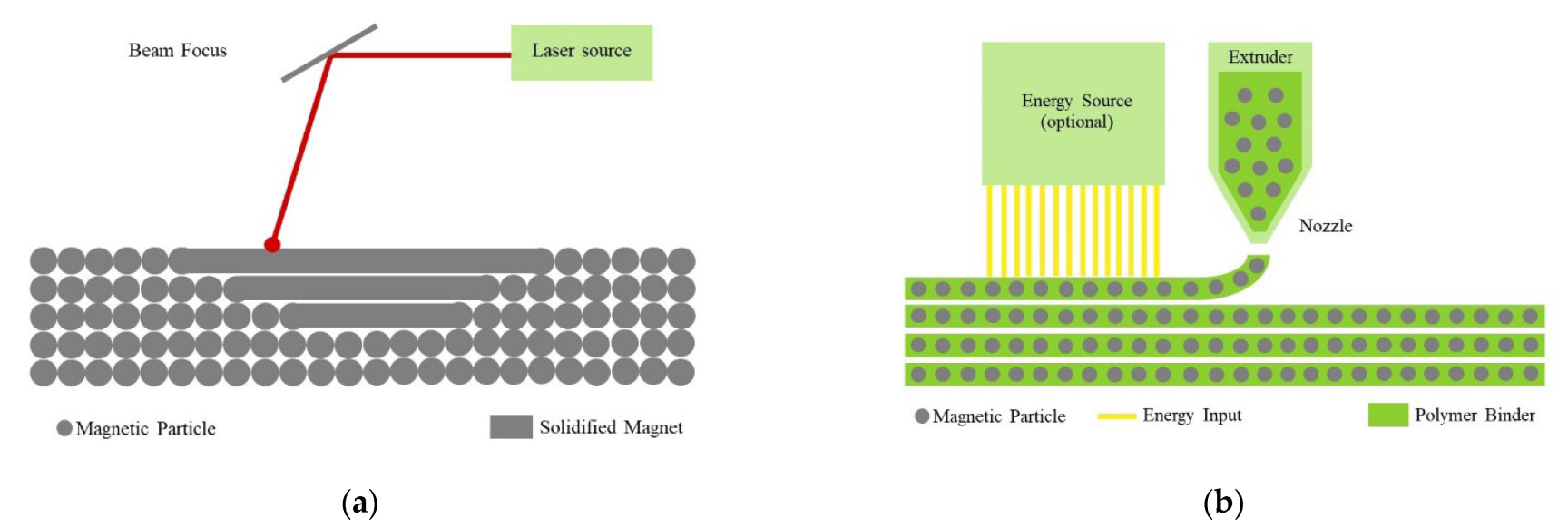A new paper published by researchers from Thailand has summarized various options for 3D printing magnets.
The paper gathers together different methods and processes for the 3D printing of magnets including Stereolithography, binder jetting, selective laser melting, electron beam melting, extrusion free-forming, and FDM.
Let’s have a look at what your options are should you ever find yourself in need of a printed magnet. But first, let’s look at why you would 3D print one in the first place.
Traditional Magnets
The paper is titled “Recent Developments in 3D Printing of Rare-Earth-Free Permanent Magnets” so it is concerned with magnets that are always “on”, rather than electromagnets and softer ferromagnets, the latter of which can lose magnetism over time.
Magnets from common elements such as iron, cobalt or nickel or other alloys, are examined in the paper, and rare Earth materials such as neodymium and samarium are ignored. Rare Earth elements are, by definition, uncommon, and so reliance on these elements can cause supply chain issues.
Permanent magnets tend to be made from harder materials such as the rare Earth elements, with the more common ferromagnetic elements losing their magnetism quickly. Much of the research into 3D printed magnets is focused on manufacturing hard permanent magnets with more common materials.
These permanent magnets are typically manufactured by melting the appropriate metals together in a vacuum and pouring the molten metal into a mold or into strips. The cured metal is then pulverized into powder. This powder is very reactive and so must be free from exposure to oxygen, lest it go “bang”!
The powder is then compressed into a mold, and just before the compression it is exposed to a magnetic field to align the magnetic regions in the right direction.

After it is compressed, it is vacuum sintered, bonding it all together and making the magnet dense. Depending on the materials used, additional heat treatment may take place next.
After all sintering and heat treatments are complete, it is time to machine or grind the magnet to the net shape part. Some magnets decrease in size significantly as they cool, so machining ensures that the part is accurate and the surface finish is acceptable. Neodymium magnets require coating due to their chemical reactivity.
The next step is magnetizing. The net shape parts are loaded into a machine such as a solenoid, and large magnetic fields are blasted at the parts, producing an external magnetic field in them.
Finally, the charged magnets are stabilized to prevent any losses of field strength, and then calibrated to a required magnetic field level.
That is a very loose summary of how permanent magnets are made, and as you can see from the multiple appearances of the word “vacuum”, this is a complicated and expensive process.
These high costs of manufacturing combined with supply chain issues associated with rare Earth elements are why additive manufacturing has been seen as a better solution.
3D Printed Magnets
The paper looks at various types of printing processes including FDM, SLA, paste extrusion and EBM/SLM.
SLM/EBM
Alnico magnets can be made with selective laser melting (SLM) and electron beam melting (EBM). Alnico magnets are permanent magnets made of (Al), nickel (Ni), and cobalt (Co).
Magnets printed with this method have demonstrated remanence ( the ability of a material to retain magnetization)as high as 9 kG, which is comparable to cast and sintered magnets with comparable compositions.
Manganese-based magnets have also been produced with electron beam melting.
FDM
By incorporating magnetic powders in polymers such as PE, ABS and EEA and then printing via extrusion, strontium ferrite magnets have been manufactured in this manner.
Manganese aluminum-based alloys have been successfully printed by FDM/FFF, as well as by EBM.
The image below shows SLS production of magnets compared with an extrusion based method.

SLA
Hard ferrites have been successfully printed with stereolithography.
Strontium hexaferrite flakes have been mixed in with various photopolymer matrices and printed with varying degrees of success. The strontium flakes have also been mixed with epoxy and tested in material jetting processes. This confirms the validity of jetting processes in the formation of hard permanent magnets.
Conclusion
Of the 3D printed magnets, magnetic properties in some cases were comparable to those of conventional magnets with the same compositions.
The advantages of additive manufacturing technology over conventional processes have been demonstrated in producing rare-earth-free magnetic alloys and ceramics with varying shapes and dimensions.
As a summary:
Alnico magnets have been produced with SLM and EBM.
Both strontium ferrite and manganese aluminum magnets can be printed using FDM.
Hard ferrites can be printed with extruded pastes and SLA.
It was found that alloys printed by SLS and hard ferrites produced by FDM were comparable to those of conventional sintered and bonded magnets with the same compositions.
Research has shown that the magnetic properties can be enhanced by aligning magnetic particles with an external magnetic field during the extrusion of magnetic pastes or filaments (much like the pre-compression magnetization of traditional magnets)..
While it was shown that rare-earth magnets are superior in terms of magnetism,the printed magnets of the common element variety have been shown to have potential for application in electrical systems such as motors.
If you would like to read the full paper, then you can access it over at this link.

